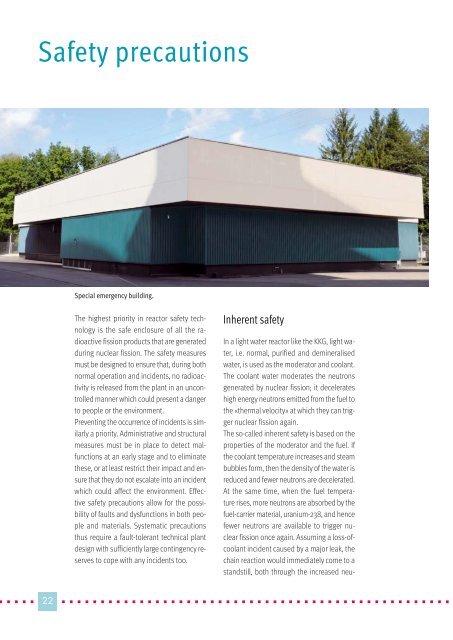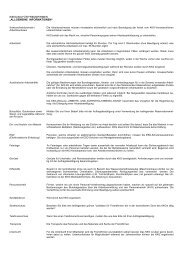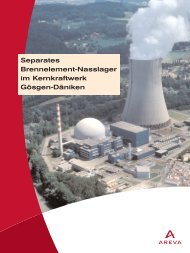Technology and Operation - Kernkraftwerk Gösgen
Technology and Operation - Kernkraftwerk Gösgen
Technology and Operation - Kernkraftwerk Gösgen
Create successful ePaper yourself
Turn your PDF publications into a flip-book with our unique Google optimized e-Paper software.
Safety precautions<br />
Special emergency building.<br />
The highest priority in reactor safety technology<br />
is the safe enclosure of all the radioactive<br />
fission products that are generated<br />
during nuclear fission. The safety measures<br />
must be designed to ensure that, during both<br />
normal operation <strong>and</strong> incidents, no radioactivity<br />
is released from the plant in an uncontrolled<br />
manner which could present a danger<br />
to people or the environment.<br />
Preventing the occurrence of incidents is similarly<br />
a priority. Administrative <strong>and</strong> structural<br />
measures must be in place to detect malfunctions<br />
at an early stage <strong>and</strong> to eliminate<br />
these, or at least restrict their impact <strong>and</strong> ensure<br />
that they do not escalate into an incident<br />
which could affect the environment. Effective<br />
safety precautions allow for the possibility<br />
of faults <strong>and</strong> dysfunctions in both people<br />
<strong>and</strong> materials. Systematic precautions<br />
thus require a fault-tolerant technical plant<br />
design with sufficiently large contingency reserves<br />
to cope with any incidents too.<br />
Inherent safety<br />
In a light water reactor like the KKG, light water,<br />
i.e. normal, purified <strong>and</strong> demineralised<br />
water, is used as the moderator <strong>and</strong> coolant.<br />
The coolant water moderates the neutrons<br />
generated by nuclear fission; it decelerates<br />
high energy neutrons emitted from the fuel to<br />
the «thermal velocity» at which they can trigger<br />
nuclear fission again.<br />
The so-called inherent safety is based on the<br />
properties of the moderator <strong>and</strong> the fuel. If<br />
the coolant temperature increases <strong>and</strong> steam<br />
bubbles form, then the density of the water is<br />
reduced <strong>and</strong> fewer neutrons are decelerated.<br />
At the same time, when the fuel temperature<br />
rises, more neutrons are absorbed by the<br />
fuel-carrier material, uranium-238, <strong>and</strong> hence<br />
fewer neutrons are available to trigger nuclear<br />
fission once again. Assuming a loss-ofcoolant<br />
incident caused by a major leak, the<br />
chain reaction would immediately come to a<br />
st<strong>and</strong>still, both through the increased neu-<br />
� � � � �22 � � � � � � � � � � � � � � � � � � � � � � � � � � � � � � � � � � � � � � � � � � � � � � � � � � � �




